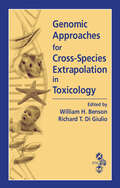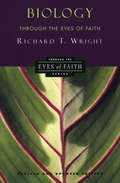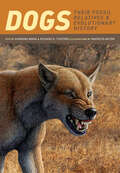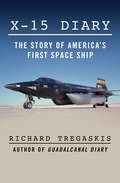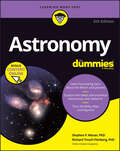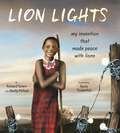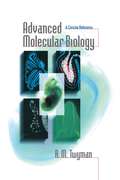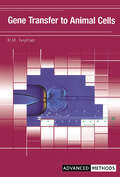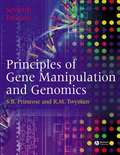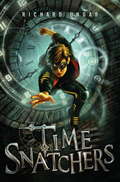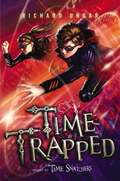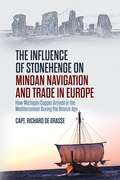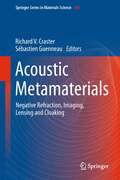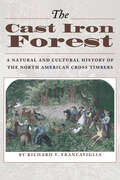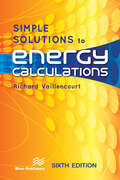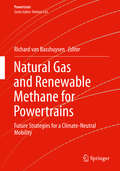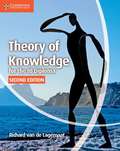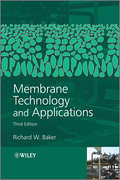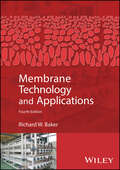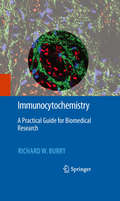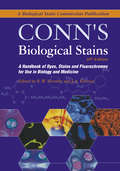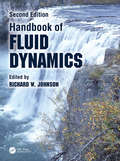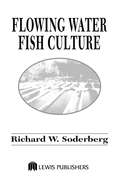- Table View
- List View
Genomic Approaches for Cross-Species Extrapolation in Toxicology
by William H. Benson Richard T. Di GiulioThe latest tools for investigating stress response in organisms, genomic technologies provide great insight into how different organisms respond to environmental conditions. However, their usefulness needs to be tested, verified, and codified. Genomic Approaches for Cross-Species Extrapolation in Toxicology provides a balanced discussion drawn from
Biology Through the Eyes of Faith
by Richard T. WrightNewly Revised The Council of Christian Colleges and Universities Series Stressing the biblical message of stewardship, biologist Richard T. Wright celebrates the study of God's creation and examines the interaction of the life sciences with society in medicine, genetics, and the environment. The author brings a biblical perspective to theories on origins, contrasting creationism, intelligent design, and evolution. Highlighting the unique nature of biology and its interaction with Christian thought, Wright demonstrates that Christian stewardship can be the key to a sustainable future. This comprehensive work, one of a series cosponsored by the Council for Christian Colleges and Universities, addresses the needs of the Christian student of biology to align science and faith. It demonstrates that the study of biology penetrates to the core of human existence and has much to contribute to the construction of a consistent Christian worldview.
Dogs: Their Fossil Relatives and Evolutionary History
by Xiaoming Wang Richard TedfordXiaoming Wang and Richard H. Tedford have spent the past 20 years studying the evolutionary history of the family Canidae. Both are well known for having established the modern framework for the evolutionary relationship of canids. Combining their research with Mauricio Antón's impeccable reconstructions of both extinct and extant species, Wang and Tedford present a remarkably detailed and nuanced portrait of the origin and evolution of canids over the past 40 million years. The authors cull their history from the most recent scientific research conducted on the vast collections of the American Museum of Natural History and other leading institutions. The fossil record of the Canidae, particularly those from their birth place in North America, are the strongest of their kind among known groups of carnivorans. Such a wonderfully detailed evolutionary history provides access to a natural history that is not possible with many other groups of carnivorans.With their rich fossil record, diverse adaptations to various environments, and different predatory specializations, canids are an ideal model organism for the mapping of predator behavior and morphological specializations. They also offer an excellent contrast to felids, which remain entrenched in extreme predatory specializations. The innovative illustrated approach in this book is the perfect accompaniment to an extremely important branch of animal and fossil study. It transforms the science of paleontology into a thrilling visual experience and provides an unprecedented reference for anyone fascinated by dogs.
X-15 Diary: The Story of America's First Space Ship
by Richard TregaskisOn August 4, 1960, the X-15 hypersonic manned rocket ship flashed high over Edwards Air Force Base, California, to a new all-time speed record of 2,196 miles an hour. A few days later, the sleek, stub-winged ship soared out of the earth's atmosphere into space to reach the world's record altitude of 136,500 feet. Now, for the first time, Richard Tregaskis, author of Guadalcanal Diary and Invasion Diary, tells the full, engrossing story that lies behind these flights. X-15 Diary marks one of America's greatest chapters in the exploration of space. In order to observe and record the development and flights of this first space ship to be sent to the edges of the infinite realm that we shall be exploring for hundreds of years to come, Richard Tregaskis since February, 1959, has virtually lived with the X-15 project. Here is his engrossing day-by-day story of the dedicated men and women involved in this dramatic enterprise sponsored by the U.S. Air Force and National Aeronautics and Space Administration. Here are the courageous test pilots such as Scott Crossfield of North American Aviation, who has survived explosions in the X-15 and has skillfully brought the rocket craft through other emergencies; Joe Walker of NASA, who attained the all-time world's speed record in the ship; Captain Bob White, U.S.-A.F., who piloted the X-15 to the highest altitude ever reached by man. Here are the brilliant engineers such as Harrison Storms and test conductor Q. C. Harvey of North American Aviation; scientists, technicians, and many others. Here too is the inside story of the baffling problems that have arisen to cause delays and setbacks; the ingenuity and endless hard work through which those obstacles have been overcome; the frightening dangers and uncertainties faced by the test pilots; and the suspense and tension of the record-breaking test flights themselves. Through the pages of the diary there also unfolds the story of earlier work by pioneers in rocketry in many countries-- the pyramid of experimentation of which the rocket ship X-15 is the apex. With its numerous illustrations, its complete and thoroughly up-to-date text, X-15 Diary is both a vivid and significant chronicle of one of America's proudest achievements and a fitting sequel to Mr. Tregaskis's distinguished war diaries.
X-15 Diary: The Story of America's First Space Ship
by Richard TregaskisThe riveting true story of the world&’s fastest plane and the first manned flights into outer space. First tested in 1959, the X-15 rocket plane was at the forefront of the space race. Developed by the US Air Force and the National Aeronautics and Space Administration (NASA) in collaboration with North American Aviation, the X-15 was sleek, black, and powerful—a missile with stubby wings and a cockpit on the nose. By 1961 it could reach speeds over three thousand miles per hour and fly at an altitude of thirty-one miles above the earth&’s surface—the lower reaches of outer space. Acclaimed journalist and bestselling author Richard Tregaskis tells the story of the X-15&’s development through the eyes of the brave pilots and brilliant engineers who made it possible. From technological breakthroughs to disastrous onboard explosions to the bone-crushing effects of intense g-force levels, Tregaskis captures all the drama and excitement of this crucial proving ground for the Mercury, Gemini, and Apollo missions. X-15 Diary recounts a thrilling chapter in the history of the American space program and serves as a fitting tribute to the courageous scientists and adventurers who dared to go where no man had gone before. This ebook features an illustrated biography of Richard Tregaskis including rare images from the American Heritage Center at the University of Wyoming.
Astronomy For Dummies (+ Chapter Quizzes Online)
by Stephen P. Maran Richard Tresch FienbergEmbark on your own personal journey into the night sky. Stardate: Today! Ever catch yourself staring up at the night sky and wondering just what the heck is out there? While no one book can answer all your questions, Astronomy For Dummies will take you on a tour through the Milky Way (and beyond!) that describes some of the most fascinating objects in the universe. This book comes complete with online access to chapter quizzes and downloadable full-color astronomical photos of our universe, as well as easy-to-follow explanations of the eye-popping wonders and gorgeous interstellar objects that populate our solar system, galaxy, and universe. You’ll find: Brand-new star charts for the northern and southern hemispheres, as well as descriptions of the latest tech tools for amateur astronomers Lists of the most recently discovered exoplanets, exomoons, and exocomets hurtling through the cosmos The latest timelines for dazzling solar events and maps to the best places to see them live and in-personFilled with discussions of the biggest and greatest new breakthroughs and an 8-page color insert packed with unbelievable, full-color photographs, Astronomy For Dummies is a can’t-miss book that will ignite a passion for understanding the mysteries of the universe in children and adults alike!
Lion Lights: My Invention That Made Peace With Lions
by Richard Turere Shelly PollockNamed an Outstanding Science Trade Book for 2022 by the National Science Teaching Association and the Children’s Book Council. California Eureka Silver Honoree 2022 A story of ingenuity and perseverance. Richard Turere’s own story: Richard grew up in Kenya as a Maasai boy, herding his family’s cattle, which represented their wealth and livelihood. Richard’s challenge was to protect their cattle from the lions who prowled the night just outside the barrier of acacia branches that surrounded the farm’s boma, or stockade. Though not well-educated, 12-year-old Richard loved tinkering with electronics. Using salvaged components, spending $10, he surrounded the boma with blinking lights, and the system works; it keeps lions away. His invention, Lion Lights, is now used in Africa, Asia, and South America to protect farm animals from predators.
Advanced Molecular Biology: A Concise Reference
by Richard TwymanAdvanced Molecular Biology emphasises the unifying principles and mechanisms of molecular biology, with frequent use of tables and boxes to summarise experimental data and gene and protein functions. Extensive cross-referencing between chapters is used to reinforce and broaden the understanding of core concepts. This is the ideal source of comprehensive, authoritative and up-to-date information for all those whose work is in the field of molecular biology. This book emphasises the unifying principles and mechanisms of molecular biology, with frequent use of tables and boxes to summarise experimental data and gene and protein functions.
Gene Transfer to Animal Cells (Advanced Methods)
by Richard TwymanGene transfer to animal cells was first achieved more than thirty years ago. Since then, transformation technology has developed rapidly, resulting in a multitude of techniques for cell transformation and the creation of transgenic animals. As with any expanding technology, it becomes difficult to keep track of all the developments and to find a concise and comprehensive source of information that explains all the underlying principles. Gene Transfer to Animals Cells addresses this problem by describing the principles behind gene transfer technologies, how gene expression is controlled in animal cells and how advanced strategies can be used to add, exchange or delete sequences from animal genomes in a conditional manner. A final chapter provides an overview of all the applications of animal cell transformation in farming, medicine and research.
Principles of Gene Manipulation and Genomics
by Richard Twyman Sandy B. PrimroseThe increasing integration between gene manipulation and genomics is embraced in this new book, Principles of Gene Manipulation and Genomics, which brings together for the first time the subjects covered by the best-selling books Principles of Gene Manipulation and Principles of Genome Analysis & Genomics. Comprehensively revised, updated and rewritten to encompass within one volume, basic and advanced gene manipulation techniques, genome analysis, genomics, transcriptomics, proteomics and metabolomics Includes two new chapters on the applications of genomics An accompanying website - www.blackwellpublishing.com/primrose - provides instructional materials for both student and lecturer use, including multiple choice questions, related websites, and all the artwork in a downloadable format. An essential reference for upper level undergraduate and graduate students of genetics, genomics, molecular biology and recombinant DNA technology.
Time Snatchers
by Richard UngarA thrilling middle-grade sci-fi Caleb's blinders are off. The small group of orphans who were also "adopted" by Uncle used to feel like family, but the competition to be the top time snatcher and the punishment for failure has gotten fierce. Time traveling to steal valuable objects can be a thrill, but with bully Frank trying to steal his snatches, his partner Abbie falling for Frank's slimy charms, and Uncle's plans to kidnap innocent kids to grow his business, Caleb starts thinking about getting out. But Uncle's reach extends to any country in any time period, and runaways get the harshest punishment of all. Caleb can steal just about anything from the past, but can he steal a family for the future? .
Time Trapped
by Richard UngarThe high-octane sequel to Time Snatchers. Caleb thought he'd escaped Uncle's clutches and could have a normal life in 1968, but no such luck. After being forcibly returned to Timeless Treasures and his old job of stealing valuable objects from the past, he learns that things have gotten even more sinister. Training the new kidnapped recruits doesn't seem very important to Frank, Uncle's evil lackey, even though a few of these kids have amazing theiving skills and genius for new technology. But then Caleb figures out it's because Frank doesn't plan on keeping them around very long - or keeping them alive. Stakes are high for all of the time snatchers. If only Caleb can convince the new ones to stop having fun with the technology and use it to save their own lives. .
Time Trapped
by Richard UngarThe high-octane sequel to Time Snatchers. Caleb thought he'd escaped Uncle's clutches and could have a normal life in 1968, but no such luck. After being forcibly returned to Timeless Treasures and his old job of stealing valuable objects from the past, he learns that things have gotten even more sinister. Training the new kidnapped recruits doesn't seem very important to Frank, Uncle's evil lackey, even though a few of these kids have amazing theiving skills and genius for new technology. But then Caleb figures out it's because Frank doesn't plan on keeping them around very long - or keeping them alive. Stakes are high for all of the time snatchers. If only Caleb can convince the new ones to stop having fun with the technology and use it to save their own lives.
The Influence of Stonehenge on Minoan Navigation and Trade in Europe: How Michigan Copper Arrived in the Mediterranean During the Bronze Age
by Richard V de GrasseThis book presents a plausible account of how thousands of tons of unusually pure copper ore from Isle Royale in northern Michigan's Lake Superior was mined and shipped to Europe by the Minoans 4500 years ago during the Bronze Age, and how Stonehenge in E
Acoustic Metamaterials: Negative Refraction, Imaging, Lensing and Cloaking (Springer Series in Materials Science #166)
by Richard V. Craster Sébastien GuenneauAbout the book: This book is the first comprehensive review on acoustic metamaterials; novel materials which can manipulate sound waves in surprising ways, which include collimation, focusing, cloaking, sonic screening and extraordinary transmission. It covers both experimental and theoretical aspects of acoustic and elastic waves propagating in structured composites, with a focus on effective properties associated with negative refraction, lensing and cloaking. Most related books in the field address electromagnetic metamaterials and focus on numerical methods, and little (or no) experimental section. Each chapter will be authored by an acknowledged expert, amongst the topics covered will be experimental results on non-destructive imaging, cloaking by surface water waves, flexural waves in thin plates. Applications in medical ultrasound imaging and modeling of metamaterials will be emphasized too. The book can serve as a reference for researchers who wish to build a solid foundation of wave propagation in this class of novel materials.
The Cast Iron Forest: A Natural and Cultural History of the North American Cross Timbers (Corrie Herring Hooks Series #43)
by Richard V. Francaviglia&“A thoughtful, thorough, and updated account of this bio-region&” from the author of From Sail to Steam: Four Centuries of Texas Maritime History, 1500-1900 (Great Plains Research). Winner, Friends of the Dallas Public Library Award, Texas Institute of Letters, 2001 A complex mosaic of post oak and blackjack oak forests interspersed with prairies, the Cross Timbers cover large portions of southeastern Kansas, eastern Oklahoma, and north central Texas. Home to indigenous peoples over several thousand years, the Cross Timbers were considered a barrier to westward expansion in the nineteenth century, until roads and railroads opened up the region to farmers, ranchers, coal miners, and modern city developers, all of whom changed its character in far-reaching ways. This landmark book describes the natural environment of the Cross Timbers and interprets the role that people have played in transforming the region. Richard Francaviglia opens with a natural history that discusses the region&’s geography, geology, vegetation, and climate. He then traces the interaction of people and the landscape, from the earliest indigenous inhabitants and European explorers to the developers and residents of today&’s ever-expanding cities and suburbs. Many historical and contemporary maps and photographs illustrate the text. &“This is the most important, original, and comprehensive regional study yet to appear of the amazing Cross Timbers region in North America . . . It will likely be the standard benchmark survey of the region for quite some time.&” —John Miller Morris, Assistant Professor of Geography, University of Texas at San Antonio
Simple Solutions to Energy Calculations
by Richard VaillencourtUpdated with new material, this book shares the author’s secrets for simplifying complex energy calculations, and shows you how to use these time-saving methods. It shows you how to cut through the maze using innovative decision-making tools to determine whether you should invest real time and money for developing details of a project being considered. There is information covered on simplified thermodynamics that gives you a blueprint for controlling the building’s energy consumption. Key topics covered include the walk-through audit, pumps & fans VFD, high efficiency motors, insulation, fuel switching, heat recovery, HVAC, air compressor, "energy myths and magic". Each chapter has "Richard’s Retrofit Rules" and anecdotal experience in the retrofit. There is a summary of energy calculations given by category, plus a discussion of performance guarantees that helps a building manager decide which ESCO can best deliver on their promises of energy savings.
Natural Gas and Renewable Methane for Powertrains
by Richard Van BasshuysenThis book focuses on natural gas and synthetic methane as contemporary and future energy sources. Following a historical overview, physical and chemical properties, occurrence, extraction, transportation and storage of natural gas are discussed. Sustainable production of natural gas and methane as well as production and storage of synthetic methane are scrutinized next. A substantial part of the book addresses construction of vehicles for natural and synthetic methane as well as large engines for industrial and maritime use. The last chapters present some perspectives on further uses of renewable liquid fuels as well as natural gas for industrial engines and gas power plants.
Theory of Knowledge for the IB Diploma Second Edition
by Richard Van de LagemaatWritten by experienced practitioners this resource for Theory of Knowledge for the IB Diploma offers comprehensive coverage of and support for the new subject guide. This edition of Theory of Knowledge for the IB Diploma is fully revised for first examination in September 2015. The coursebook is a comprehensive, original and accessible approach to Theory of Knowledge, which covers all aspects of the revised subject guide. A fresh design ensures the content is accessible and user friendly and there is detailed guidance on how to approach the TOK essay and presentation. This edition supports the stronger emphasis on the distinction between personal and shared knowledge and the new areas of knowledge: religion and indigenous knowledge.
Membrane Technology and Applications
by Richard W. Baker"... the best handbook on membrane technology, which is currently on the market... " -Membrane News (on the previous edition)Building on the success of the previous edition, Membrane Technology and Applications Third Edition provides a comprehensive overview of separation membranes, their manufacture and their applications. Beginning with a series of general chapters on membrane preparation, transport theory and concentration polarization, the book then surveys several major areas of membrane application in separate chapters. Written in a readily accessible style, each chapter covers its membrane subject thoroughly, from historical and theoretical backgrounds through to current and potential applications. Topics include reverse osmosis, ultrafiltration, pervaporation, microfiltration, gas separation and coupled and facilitated transport; chapters on electrodialysis and medical applications round out the coverage.NEW TO THE THIRD EDITIONNew sections on the use of membranes in the chlor-alkali industry, membrane distillation, pressure retarded osmosis and constant flux-variable pressure ultrafiltrationZeolite and ceramic membranes, submerged membrane modules, and fuel cell membranesSubstantially enhanced chapters on ultrafiltration, pervaporation and membrane contactorsUpdates to every chapter to reflect the developments in the field
Membrane Technology and Applications
by Richard W. BakerMembrane Technology and Applications Internationally acknowledged text on separation membrane technology, presenting current theory and practice, plus manufacturing and applications The 4th Edition of Membrane Technology and Applications presents an authoritative, up-to-date overview of separation membranes, their theoretical underpinnings, manufacture, and use, beginning with a series of general chapters on membrane preparation, transport theory, and concentration polarization, then surveying the major areas of membrane application in separate chapters. Written in a readily accessible style, each chapter offers a thorough treatment of its subject, from historical and theoretical backgrounds through to current and potential applications. Topics include reverse osmosis, ultrafiltration, microfiltration, gas separation, pervaporation, electrodialysis, coupled and facilitated transport, and medical applications of membranes. This new edition has been comprehensively updated, with substantial new material, figures, and references throughout to reflect the latest developments in the field. Major changes include: A new chapter on transport mechanisms in finely microporous membranes, with focus on gas transport A new chapter on membrane contactors A substantially expanded section on hyperfiltration applications, including pharmaceutical applications, in the reverse osmosis chapter Expanded treatment of membrane bioreactors, plus a new section on biotechnology applications, in the ultrafiltration chapter A new section in the gas separation chapter devoted to carbon dioxide capture from industrial process emissions, including power plant emissions Research areas that the author would work on if he were, once again, a 21-year-old graduate student. Written by a leading expert with 50 years of experience, Membrane Technology and Applications provides balanced coverage of all aspects of the field, and is essential reading for all membrane enthusiasts, from neophyte graduate student to academic researcher to seasoned industry professional.
Immunocytochemistry
by Richard W. BurryDescription: In biomedical research, because of a dramatic increase in productivity, immunocytochemistry has emerged as a major technique. The proposed book will provide the first practical guide to planning, performing, and evaluating immunocytochemical experiments. In today's graduate education the emphasis is on doing research and not on formal class work. Graduate students therefore lack the background in many essential techniques necessary to perform research in fields in which they were not trained. As director of a university core microscopy facility which sees students and faculty from dozens of laboratories each year, Dr. Burry has surmised the vast majority of these novice microscope users need considerable help. In an attempt to educate users, Dr. Burry has initiated immunocytochemistry seminars and workshops which serve to train people in this powerful research tool. The proposed book is an outgrowth of these presentations and conversations with, by now, hundreds of people who have asked for help. The philosophy which separates this book from other books in this field is that it is practical, rather than academic. In looking at other important immunocytochemistry titles, the predominant orientation is academic, with the author attempting to comprehensively discuss the topic. For example, one book with sample preparation lists ten fixatives which can be used; however, only two such fixatives are commonly used today. In this particular title, the detailed discussion of old methods might be seen as important in establishing the author as an expert. By contrast, the approach for Burry's book would be to discuss methods based on what works in animal research laboratories today, and focus only on the most productive methods. An additional distinction with this proposed book is the focus on animal research and not human pathology. There is a certification program for pathology technicians which requires them to learn a set body of material based on processing human tissue for examination by a pathologist. Many of the books on immunocytochemistry aim at this large pathology user base. Due to historical reasons, pathology laboratories process human tissues in a specific way and embed the tissue in paraffin, as has been done for over a century. In the last ten years, the power of immunocytochemistry in clinical diagnosis has become clear and has accordingly been adapted to pathology. However, the extensive processing needed for paraffin sections is not needed if the tissues are from research animals. Processing for animal-based tissues takes about a third of the time and results in higher quality images. The focus of this book is on processing these animal research tissues for immunocytochemistry. Today, there are no technique books which are aimed at this user base. As a subject matter expert in the area of the proposed book, Dr. Burry will make recommendations and offer opinions. Because this field is new and is emerging, there are numerous advantages of specific methods over other, more generalized methods. The purpose of this book is to show a novice how to do immunocytochemistry without engaging in a discussion of possible advanced methods. For the advanced user, there are several good books which discuss the unusual methods, yet for the novice there are currently none. Main Author : Richard W. Burry, The Ohio State University (United States). The Outline of the Book : Each chapter supplies a set of important principals and steps necessary for good immunocytochemistry. The information is distilled down to include only the most important points and does not attempt to cover infrequently used procedures or reagents. At the end of most chapters is a section on trouble-shooting many of the common problems using the Sherlock Holmes method. Each chapter also includes specific protocols which can be used. The goal of each chapter is to present the reader with enough information to successfully design experiments and solve many of the problems one may encounter. Using immunocytochemical protocols without t...
Conn's Biological Stains: A Handbook of Dyes, Stains and Fluorochromes for Use in Biology and Medicine
by Richard W. Horobin and John A. KiernanPublished on behalf of the Biological Stain CommissionFor 75 years Conn's Biological Stains has been a standard reference for all those who used dyes and colorants in the biological and medical sciences. This long awaited tenth edition appears 25 years after R.D. Lillie's ninth and has been completely rewritten to reflect the increase in range of uses. Although the staining of microscopical preparations continues to expand the uses of dyes and fluorochromes now extend far beyond this traditional application.This book provides the first critical overview of the whole range of low molecular weight fluorescent probes, outside the catalogue literature. The first ten chapters are essays, by leading experts, on the important aspects of colorants and their uses. Most of the remainder of the book consists of descriptions by Dr Horobin of the properties and recent applications of hundreds of individual compounds, in about twenty chemical classes. The last chapter reviews the procedures employed at the Biological Stain Commission's laboratory to assay and test dyes and certify them as suitable for their intended applications.
Handbook of Fluid Dynamics
by Richard W. JohnsonHandbook of Fluid Dynamics offers balanced coverage of the three traditional areas of fluid dynamics—theoretical, computational, and experimental—complete with valuable appendices presenting the mathematics of fluid dynamics, tables of dimensionless numbers, and tables of the properties of gases and vapors. Each chapter introduces a different fluid dynamics topic, discusses the pertinent issues, outlines proven techniques for addressing those issues, and supplies useful references for further research.Covering all major aspects of classical and modern fluid dynamics, this fully updated Second Edition: Reflects the latest fluid dynamics research and engineering applications Includes new sections on emerging fields, most notably micro- and nanofluidics Surveys the range of numerical and computational methods used in fluid dynamics analysis and design Expands the scope of a number of contemporary topics by incorporating new experimental methods, more numerical approaches, and additional areas for the application of fluid dynamics Handbook of Fluid Dynamics, Second Edition provides an indispensable resource for professionals entering the field of fluid dynamics. The book also enables experts specialized in areas outside fluid dynamics to become familiar with the field.
Flowing Water Fish Culture
by Richard W. SoderbergFlowing Water Fish Culture provides an in-depth discussion of the husbandry of fin fish in a stream of water. It guides the reader through the technical considerations of intensive aquaculture, including fish growth rates, hydraulic characteristics of fish rearing units, oxygen consumption rates in relation to oxygen solubility and fish tolerance of hypoxia, and water reconditioning by reaeration and ammonia filtration. Unlike other publications that provide only general overviews on the subject, this text/reference offers specific details that will be useful in the actual design and operation of a facility. Problem sets at the end of each chapter provide ample opportunity to develop skills. The information in the book is valuable for those teaching, considering, or practicing aquaculture at intensity levels ranging from conventional single-pass trout hatcheries to closed aquaculture systems.
